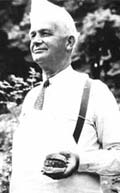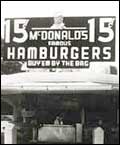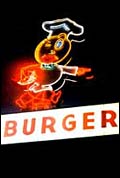Hamburger Multimedia |
|
 |
Watch an early McDonald's commercial. (© 1999 McDonald's Corp.) |
 |
Listen to Ray Kroc dictate a message to the McDonald brothers about the chain's hamburgers. (© 1999 McDonald's Corp.) |
 |
Listen to an obituary of Wendy's founder Dave Thomas, from All Things Considered, Jan. 8, 2002. |
 |
Listen to an obituary of McDonald's co-founder Richard McDonald, from All Things Considered, July 15, 1998. |
 |
The Hamburger
 Listen to Pam Fessler's report. Listen to Pam Fessler's report.
 View a photo gallery about the hamburger. View a photo gallery about the hamburger. Watch an early McDonald's commercial and listen to more hamburger history. Watch an early McDonald's commercial and listen to more hamburger history. |
July 15, 2002 -- Ah, summertime. Long afternoons that stretch into lazy evenings. The taste of lemonade, the sound of the ice cream truck as it rolls slowly down the block, and the smell of hamburgers grilling from back porches and freshly cut lawns.
Of course, we don't just eat hamburgers during the summer months. Over the course of each year, Americans consume about 14 billion burgers. And we don't always have time to grill them ourselves. But that's part of the beauty of the sandwich that has few competitors in the race for America's favorite food. Its simplicity and convenience, coupled with the fact that it can be dressed up almost any way imaginable -- or not at all -- have turned the hamburger into a culinary force to be reckoned with.
It's become so ingrained in our society, in fact, that it's impossible to think of American cuisine -- not to mention day-to-day life -- without it. Besides providing nourishment to millions, the popularity of the hamburger also helps fuel the beef and grain industries, and -- would you like fries with that? -- has given many a teenager their first job.
For the latest installment of Present at the Creation, NPR's Pam Fessler digs up the history of the hamburger, and finds that while just about everyone may be able to agree that burgers taste great, there's a dispute over exactly who we owe our thanks to.
Back in the dark ages of American kitchens, otherwise known as the mid-to-late 19th century, the hamburger was nowhere to be found. Sure, we had ground beef, introduced by German immigrants in the early 1800s, but a Hamburg steak is one giant white-bread step away from a hamburger.
Who was the first to slap it on a bun? As it turns out, we've got a few competitors. First up, Louis Lassen, original owner of Louis' Lunch in New Haven, Conn. Local legend submits that in 1900 one of Louis' customers wanted lunch in a hurry, so the cook put a beef patty between two slices of white bread. Simple enough. And, as if to provide evidence for the story, the restaurant adheres to that rule of simplicity today. Want ketchup or lettuce? You're out of luck. Louis' patrons have a choice of tomatoes, onions, or cheese on their burgers, and nothing else. It's just the way a hamburger should be served, the proprietors insist.
And they should know, right? Perhaps, but the town of Seymour, Wis., might beg to differ. Seymour happens to be home to the Hamburger Hall of Fame, and another claim to the burger's birthplace. Tom Duffy, a local resident, insists that one Charles Nagreen is the man to whom the long history of the hamburger can be traced. Duffy says "Hamburger Charlie" Nagreen was a vendor at a local fair in 1885 when he realized that fairgoers on the move would have an easier time eating his meatballs if he made them more portable. Two slices of white bread later, the hamburger was born.
Or was it? Another fairground, another hamburger inventor. Make that two hamburger inventors. The 1904 World's Fair in St. Louis was the location. The two men? Fletcher Davis of Texas and Frank Menches of Ohio. The respective families of each say it was their relative who came up with the sandwich.
Lassen, Nagreen, Davis, Menches. Take your pick. One thing that's not in dispute, however, is the reason hamburgers became so popular around the turn of the century. Jeffrey Tennyson, author of Hamburger Heaven: The Illustrated History of the Hamburger, says it's very possible that more than one person came up with the idea at the same time. In a changing landscape, it was an idea just waiting to happen.
"As the country grew, America (was) on the run, the cities growing, people in automobiles," Tennyson says. "It was the perfect culinary concoction. And the bottom line is it tasted pretty great."
The wide-open spaces of America and its growing automobile culture helped make the hamburger an even bigger success with the advent of the burger chain restaurant. The very first chain sprouted in Wichita, Kan., under the supervision of Walter Anderson and Billy Ingram. In 1921, they opened their first White Castle outlet, and by 1930, says Tennyson, there were more than 100 restaurants, all serving the exact same burger.
But it was the brothers McDonald, Richard and Maurice, who opened the fast-food floodgates. The first McDonald's opened in 1948, but business really took off in 1954, when the brothers met Ray Kroc. They agreed to let Kroc franchise the restaurants, which had an assembly-line production policy that meant short lines and inexpensive burgers. One decade after Kroc came aboard, McDonald's had opened 657 restaurants.
Today McDonald's is the most popular hamburger in America, but it's far from the only option. From gourmet burgers to meatless soy patties at backyard barbecues, hamburger lovers have plenty to choose from. And while we may never discover exactly who it was that first came up with the idea, one thing is clear. Burgers have been filling American stomachs for a century now, and show no signs of going away.
In Depth
 Fast Food and Animal Rights: McDonald's New Farm
Fast Food and Animal Rights: McDonald's New Farm
 Search for more stories about hamburgers.
Search for more stories about hamburgers.
Other Resources
• Stop by Louis' Lunch of New Haven, Conn., one of the earliest purveyors of hamburgers.
• Read a history of the White Castle hamburger chain.
• Review a history of the hamburger.
• Read the McDonald's story.
• Learn more about the Hamburger Hall of Fame, in Seymour, Wis., home of "Hamburger Charlie" Nagreen.
• Search for hamburger recipes at Epicurious, Allrecipes.com and the Texas Beef Council.
• Read about one of the most memorable TV commercials of all time, the Wendy's "Where's the Beef?" ad.
Of course, we don't just eat hamburgers during the summer months. Over the course of each year, Americans consume about 14 billion burgers. And we don't always have time to grill them ourselves. But that's part of the beauty of the sandwich that has few competitors in the race for America's favorite food. Its simplicity and convenience, coupled with the fact that it can be dressed up almost any way imaginable -- or not at all -- have turned the hamburger into a culinary force to be reckoned with.
It's become so ingrained in our society, in fact, that it's impossible to think of American cuisine -- not to mention day-to-day life -- without it. Besides providing nourishment to millions, the popularity of the hamburger also helps fuel the beef and grain industries, and -- would you like fries with that? -- has given many a teenager their first job.
For the latest installment of Present at the Creation, NPR's Pam Fessler digs up the history of the hamburger, and finds that while just about everyone may be able to agree that burgers taste great, there's a dispute over exactly who we owe our thanks to.
Back in the dark ages of American kitchens, otherwise known as the mid-to-late 19th century, the hamburger was nowhere to be found. Sure, we had ground beef, introduced by German immigrants in the early 1800s, but a Hamburg steak is one giant white-bread step away from a hamburger.
Who was the first to slap it on a bun? As it turns out, we've got a few competitors. First up, Louis Lassen, original owner of Louis' Lunch in New Haven, Conn. Local legend submits that in 1900 one of Louis' customers wanted lunch in a hurry, so the cook put a beef patty between two slices of white bread. Simple enough. And, as if to provide evidence for the story, the restaurant adheres to that rule of simplicity today. Want ketchup or lettuce? You're out of luck. Louis' patrons have a choice of tomatoes, onions, or cheese on their burgers, and nothing else. It's just the way a hamburger should be served, the proprietors insist.
And they should know, right? Perhaps, but the town of Seymour, Wis., might beg to differ. Seymour happens to be home to the Hamburger Hall of Fame, and another claim to the burger's birthplace. Tom Duffy, a local resident, insists that one Charles Nagreen is the man to whom the long history of the hamburger can be traced. Duffy says "Hamburger Charlie" Nagreen was a vendor at a local fair in 1885 when he realized that fairgoers on the move would have an easier time eating his meatballs if he made them more portable. Two slices of white bread later, the hamburger was born.
Or was it? Another fairground, another hamburger inventor. Make that two hamburger inventors. The 1904 World's Fair in St. Louis was the location. The two men? Fletcher Davis of Texas and Frank Menches of Ohio. The respective families of each say it was their relative who came up with the sandwich.
Lassen, Nagreen, Davis, Menches. Take your pick. One thing that's not in dispute, however, is the reason hamburgers became so popular around the turn of the century. Jeffrey Tennyson, author of Hamburger Heaven: The Illustrated History of the Hamburger, says it's very possible that more than one person came up with the idea at the same time. In a changing landscape, it was an idea just waiting to happen.
"As the country grew, America (was) on the run, the cities growing, people in automobiles," Tennyson says. "It was the perfect culinary concoction. And the bottom line is it tasted pretty great."
The wide-open spaces of America and its growing automobile culture helped make the hamburger an even bigger success with the advent of the burger chain restaurant. The very first chain sprouted in Wichita, Kan., under the supervision of Walter Anderson and Billy Ingram. In 1921, they opened their first White Castle outlet, and by 1930, says Tennyson, there were more than 100 restaurants, all serving the exact same burger.
But it was the brothers McDonald, Richard and Maurice, who opened the fast-food floodgates. The first McDonald's opened in 1948, but business really took off in 1954, when the brothers met Ray Kroc. They agreed to let Kroc franchise the restaurants, which had an assembly-line production policy that meant short lines and inexpensive burgers. One decade after Kroc came aboard, McDonald's had opened 657 restaurants.
Today McDonald's is the most popular hamburger in America, but it's far from the only option. From gourmet burgers to meatless soy patties at backyard barbecues, hamburger lovers have plenty to choose from. And while we may never discover exactly who it was that first came up with the idea, one thing is clear. Burgers have been filling American stomachs for a century now, and show no signs of going away.
In Depth
 Fast Food and Animal Rights: McDonald's New Farm
Fast Food and Animal Rights: McDonald's New Farm
 Search for more stories about hamburgers.
Search for more stories about hamburgers.
Other Resources
• Stop by Louis' Lunch of New Haven, Conn., one of the earliest purveyors of hamburgers.
• Read a history of the White Castle hamburger chain.
• Review a history of the hamburger.
• Read the McDonald's story.
• Learn more about the Hamburger Hall of Fame, in Seymour, Wis., home of "Hamburger Charlie" Nagreen.
• Search for hamburger recipes at Epicurious, Allrecipes.com and the Texas Beef Council.
• Read about one of the most memorable TV commercials of all time, the Wendy's "Where's the Beef?" ad.


His descendents say Charles "Hamburger Charlie" Nagreen of Seymour, Wis., seen here in a 1950 photo, invented the hamburger in 1885, when he was 15.
Photo: © Jeffrey Tennyson, Hamburger Heaven

Louis Lassen of Louis' Lunch in New Haven, Conn., reportedly created the hamburger sandwich in 1900, when he tossed a grilled beef patty between two slices of white bread for a customer in a hurry.
Photo: Library of Congress
View enlargement.

Richard and Maurice (Dick and Mac) McDonald opened their self-service restaurant in 1948 in San Bernardino, Calif. In 1954, they made a franchise deal with Ray Kroc and the worldwide McDonald's chain was born.
Photo: McDonald's Corp.
View enlargement.

Speedy, the original McDonald's mascot, lights up the night in Downey, Calif.
Photo: © Jeffrey Tennyson, Hamburger Heaven
View enlargement.